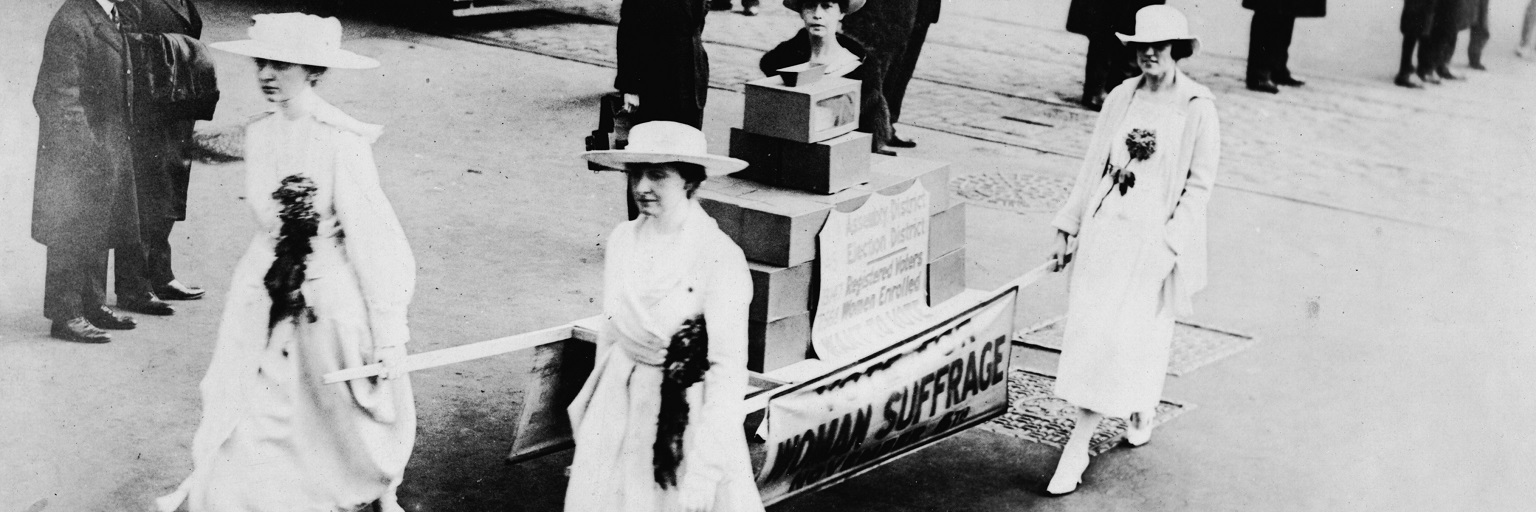Amendment XIX of the United States Constitution
Section 1.
The right of citizens of the United States to vote shall not be denied or abridged by the United States or by any State on account of sex.
Section 2.
Congress shall have power to enforce this article by appropriate legislation.
Ratified August 18, 1920.
Long Fight for Women’s Suffrage
In the United States, while citizenship has been a prerequisite to voting, voting had not been considered a fundamental right and privilege of citizenship until the 20th century. This concept is exemplified in the fight for Women’s Suffrage over the course of the 19th century and into the 20th, culminating in the ratification of the 19th Amendment in 1920. Women organized and campaigned for the right to vote, declaring their equality with men and demand for suffrage with Elizabeth Cady Stanton at the Seneca Falls Convention in 1848, were arrested and convicted for illegally voting like Susan B. Anthony, brought constitutional challenges to restrictions on voting under the 14th Amendment such as in Minor v. Happersett (1875), and joined organizations advocating for Women’s Suffrage such as the National American Woman Suffrage Association and the National Woman’s Party. In 1917, suffragists including Alice Paul demonstrated in front of the White House protesting President Wilson’s refusal to support a Women’s Suffrage amendment, and were arrested. Paul went on a hunger strike in jail. President Wilson eventually relented and announced his support for passage and ratification of what would be the 19th Amendment.
After Suffrage: Equality & Anti-Discrimination
After ratification of the 19th Amendment, Alice Paul would push for an Equal Rights Amendment (ERA) where “Equality of rights under the law shall not be denied or abridged by the United States or by any state on account of sex.” Despite decades of activism, the ERA has yet to be ratified. The Women’s Suffrage movement did pave the way for the fight for equality and anti-discrimination laws on the federal and state level, leading to legislation including the Equal Pay Act of 1963, as well as the Civil Rights Act of 1964, and Title IX Education Amendments in 1972. The Supreme Court also began to strike down discriminatory laws under the Equal Protection Clause of the 14th Amendment, such as in Reed v. Reed (1971).
United States v. Susan B. Anthony (1873)
In 1872, suffragist Susan B. Anthony cast her ballot in Rochester, New York and voted in the 1872 Presidential election, violating New York law that permitted only men to vote. Anthony argued that under the 14th Amendment, she had the constitutional right to vote as a citizen of the United States and under the Amendment, which prohibited states from abridging the “privileges” of citizens. Anthony was indicted, tried, and convicted for illegally voting. Learn More
Minor v. Happersett (1875)
The Supreme Court held that states could choose to restrict voting, barring women, because voting was not an inherent right of citizenship and was not considered an inherent right of citizenship at the time of the founding. The Constitution did not grant the right to vote to women nor prohibit the right to vote, but rather it only addressed states denying or abridging the right to vote based on discrimination concerning “race, color, or previous condition of servitude” in the 15th Amendment, and not gender. Furthermore, the state restrictions did not violate the 14th Amendment, as the right to vote was not part of the “privileges or immunities” of citizens protected under this Amendment. Learn More
- Post-Civil War Era (1865-1900): 11.4 (b)
- Industrialization and Urbanization (1870-1920): 11.5 (b)
- Social and Economic Change/Domestic Issues (1945-Present): 11.10 (b)
- Foundations of American Democracy: 12.G1 (f)
- Civil Rights and Civil Liberties: 12.G2 (a), 12.G2 (d)
- Rights, Responsibilities, and Duties of Citizenship: 12.G3 (a), 12.G3 (b)
- Ellen Carol DuBois, Women’s Long Battle for the Vote (2020)
- “U.S. v. Susan B. Anthony: The Fight for Women’s Suffrage,” Famous Federal Trials, posted by the Federal Judicial Center, includes information and teaching resources
- Recommended Readings, posted by the National Women’s History Museum
“Woman Suffrage and the 19th Amendment,” includes primary documents, information, and activities, posted by the National Archives
“The Trial of Susan B. Anthony,” Classroom Reenactment activity, under Reenactments– Historic Courtroom Theater, posted by Justice for All: Courts and the Community Initiative
Educational Resources, including various lesson plans, under Crusade for the Vote, posted by the National Women’s History Museum
“The Racial Divide in the Women’s Suffrage Movement | The Vote,” includes video and discussion questions, posted by PBS LearningMedia

